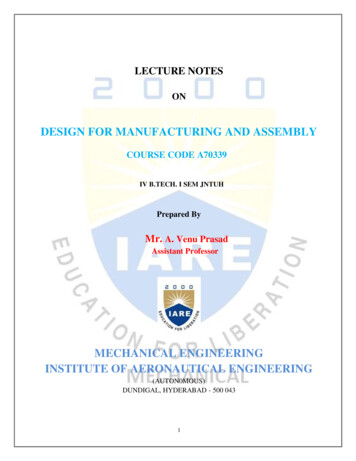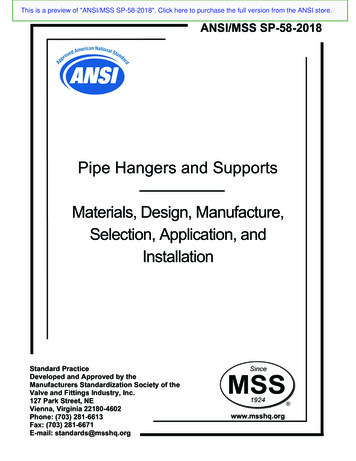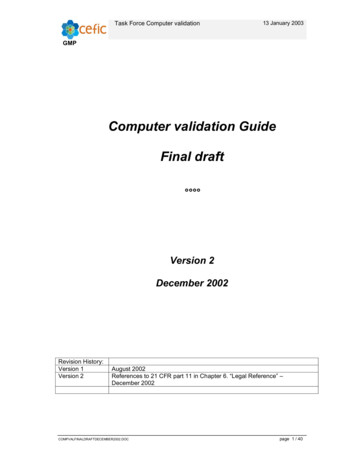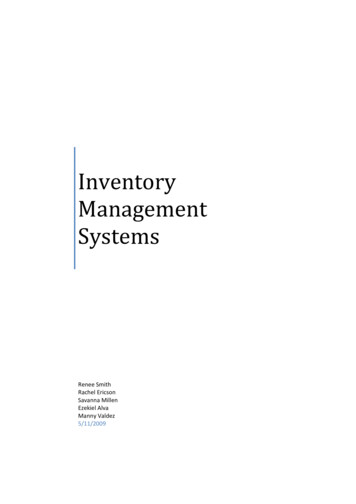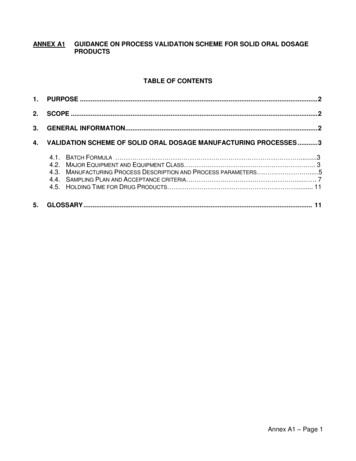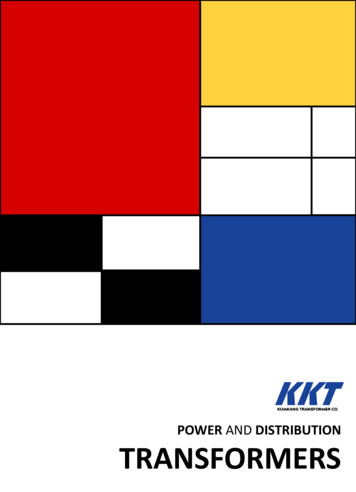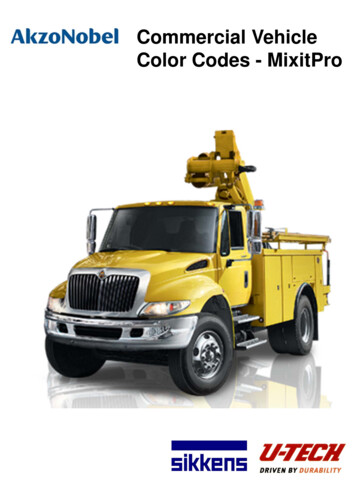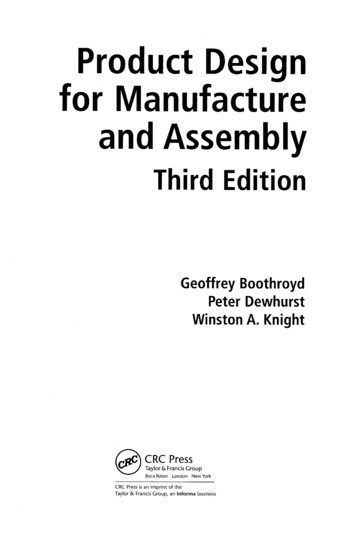
Transcription
Product Designfor Manufactureand AssemblyThird EditionGeoffrey BoothroydPeter DewhurstWinston A. KnightCRC PressTaylor &. Francis GroupBoca RatonLondonNew YorkCRC Press is an imprint of theTaylor& FrancisGroup,aninforma business
ContentsPrefacePrefacex*xtothe Second EditionxxiPreface to the First EditionxxiiiAuthorsxxvNomenclaturexxvii1. Introduction11.1What Isfor Manufacture and1.2History11.3Implementation of Design for Assembly41.4Design for Manufacture51.5Producibility1.6How Does DFMA Work?1.7Falsely ClaimedDesign1Assembly?Guidelines58Reasons for NotImplementingDFMA151.7.1No Time151.7.2Not Invented Here151.7.3151.7.4Ugly Baby SyndromeLow Assembly Costs1.7.5Low Volume171.7.6We Have Been17151.7.8Doing It for YearsIt Is Only Value AnalysisDFMA Is Only One among Many Techniques1.7.9DFMA Leads1.7.10I Prefer1.7.11I Refuse to Use DFMA1.7.7toProducts thatare more1717DifficulttoServiceDesign Rules1818181.8What Are the191.9Overall221.10ConclusionsAdvantages of Applying DFMA during Product Design?Impact of DFMA on U.S. Industry23References262. Selection of Materials and Processes2.1Introduction2.2General2929forEarly Materials and Process SelectionRequirementsRelationship to Process and Operations PlanningSelection of Manufacturing ProcessesProcess Capabilities2.4.1General Shape Attributes2.4.2DFA Compatibility Attributes29Selection of Materials352.2.12.32.42.52.62.7of Materials into Process2.5.1Grouping2.5.2Material Selection2.5.3Material SelectionPrimary n Modificationby Membershipby Dimensionless RankingSelectionSelection of Processes and Materials31313434353541435257vii
viiiContents2.7.12.7.22.7.3Computer-Based Primary Process/Material SelectionExpert Processing Sequence SelectorEconomic Ranking of ProcessesReferences3. ProductDesignfor ManualIntroduction3.2GeneralAssembly73Guidelines for Manual3.7DesignAssemblyDesign Guidelines for Part Handling3.2.2Design Guidelines for Insertion and FasteningDevelopment of the Systematic Design for Assembly MethodologyAssembly EfficiencyClassification SystemsEffect of Part Symmetry on Handling TimeEffect of Part Thickness and Size on Handling Time3.8Effect of3.9Parts3.10Effects of Combinations of Factors3.11Effect wo Hands forSymmetryMay RequireHandlingTimeTweezers for747479818285888990Manipulationfor Parts That7490Severely Nest orGraspingandTangleManipulationand903.12Effect of Chamfer3.13Estimation of Insertion Time943.14Avoidingduring AssemblyReducing Disc-Assembly Problems953.153.16Effects of Obstructed Access and Restricted Vision on Insertion3.17Effects of Obstructed Access and Restricted Vision onDesignonInsertionJamsof Threaded Fasteners of nsOperationsEffects of Holding DownManual Assembly Database and Design Data SheetsApplication of the DFA Methodology3.20.1 Results of the AnalysisFurther Design GuidelinesLarge AssembliesTypes of Manual Assembly MethodsEffect of Assembly Layout on Acquisition TimesAssembly QualityApplying LearningCurves to the DFA . Electrical Connections and Wire Harness4.1Introduction4.2Wire4.3Types of Electrical ConnectionsCable HarnessorAssembly133133Assembly1351384.3.1Solder Connections1394.3.2Low-Pressure Connections139High-Pressure ConnectionsTypes of Wires and CablesPreparation and Assembly 44
Contents*x4.5.11444.5.3PreparationAssembly and .24.65.Analysis1501554.6.1Procedure1634.6.2Case Study165References184Design for High-Speed Automatic Assembly and Robot Assembly1855.1Introduction1855.25.3Design ofExample5.4Additional5.55.65.75.85.95.105.11Parts for1896.3193197198198203206206206206212for Manufacture andAssembly219219Design Sequencefor Printed Circuit Boards219of Printed Circuit Boards2206.3.1Number of Sides2206.3.2Number of2216.3.3Board onTypes1932187.6. Printed Circuit Board6.2186Feeding DifficultiesHigh-Speed Automatic InsertionExampleAnalysis of an AssemblyGeneral Rules for Product Design for AutomationDesign of Parts for Feeding and OrientingSummary of Design Rules for High-Speed Automatic Assembly5.10.1 Rules for Product Design5.10.2 Rules for the Design of PartsProduct Design for Robot Assembly5.11.1 Summary of Design Rules for Robot AssemblyReferences6.1High-Speed Feeding and OrientingLayersTypesCopper Weight222Bare Board Manufacture2226.4.1Basic Bare Board Costs2236.4.2Number of Boards per PanelHole Drilling2256.4.36.5Optional Bare Board Processes6.4.5Bare Board TestingTerminology6.6Assembly of Printed Circuit2266.4.46.6.1226227227BoardsAssembly Operationsfor228Through-Hole Printed6.6.1.1Automatic Dual Inline6.6.1.2Automatic Axial6.6.1.3AutomaticPackage(VCD)Circuit BoardsInsertionInsertion2292302322346.6.1.4Single Inline Package InsertionAutomatic Radial Component Insertion6.6.1.5Semiautomatic Insertion235234
Contentsx6.6.1.6Manual Insertion2356.6.1.7Robot Insertion2366.6.1.8InspectionAssembly of Surface-Mounted flowOther6.6.56.8238238Assembly 9TestingAssembly Sequences240for Printed Circuit Boards240Costs2426.7.1Costs243AssemblyComponent Insertion6.7.1.1Insertion Cost2446.7.1.2Setup Cost2466.7.1.3Rework Cost2476.7.1.4Programming Cost2476.7.2Worksheet for Printed Circuit Board6.7.3ExampleCase Studies in PCB6.8.27.SolderingSolderingEstimation of PCB6.8.16.9236Processes6.6.3.16.6.4.16.7and Rework248248AssemblyMeasuring Instrument ConnectorPower SupplyGlossaryAssemblyCosts250Board250254of Terms256References260Design for Machining2617.1Introduction2617.2Machining Using Single-Point Cutting ToolsMachining Using Multipoint ToolsMachining Using Abrasive Wheels2667.5Standardization2817.6Choice of Work Material2827.7Shape of Work MaterialMachining Basic Component Shapes7.8.1Disc-Shaped Rotational Components (L/D 0.5)7.8.2Short, Cylindrical Components (0.5 L/D 3)7.8.3Long, Cylindrical Rotational Components (L/D 3)7.8.4Nonrotational Components (A/B 3, A/C 4)7.8.5Long, Nonrotational Components (A/B 3)2847.8.62937.37.47.87.97.107.117.12Cubic, Nonrotational Components (A/BAssembly of ComponentsAccuracy and Surface FinishSummary of Design GuidelinesCost Estimating for Machined Components261275 3, A/C 4)2842842882882912932962973003017.12.1Material Cost3027.12.2Machine3037.12.3Other303Loading and UnloadingNonproductive Costs
ContentsX17.12.43037.12.5Handling between MachinesMaterial Type7.12.6 Machining Costs7.12.7 Tool Replacement Costs7.12.8 Machining Data7.12.9 Rough Grinding7.12.10 Finish Grinding7.12.11 Allowance for Grinding Wheel7.12.12 Allowance for Spark-Out7.12.13 e305307308310313Wear315315Estimating WorksheetCost Models for Machined317Components321References329Design for Injection Molding3318.1Introduction3318.2Injection Molding MaterialsMolding Cycle8.3.1Injection or Filling Stage8.3.2Cooling or Freezing Stage8.3.3Ejection and Resetting StageInjection Molding it335Clamp UnitInjection Molds8.4.28.53368.5.1Mold Construction and8.5.2MoldTypesSprue, Runner, andMolding Machine SizeMolding Cycle Time8.7.1Injection Time8.7.2Cooling Time8.7.3Mold Mold Cost Estimation8.8.1Mold Base Costs8.8.2and 9Mold Cost Point8.10Estimation of the8.11Design Example8.12Insert8.13Design Guidelines3658.14Assembly Techniques366SystemOptimum Number357of CavitiesDesignMolding364372for Sheet375Metalworking9.1Introduction9.2Dedicated Dies ividual Dies for Profile377Shearing
xiiContents9.39.49.59.69.2.2Cost of Individual9.2.3Individual Dies for9.2.4Individual Dies for Bending9.2.5Individual Dies for Deep9.2.6Miscellaneous Features3989.2.7Progressive Dies399ShearingDiesPiercing OperationsOperationsDrawing3893924009.3.1405Cycle TimesTurret PressworkingPress Brake OperationsDesign RulesDesign407410413421for Die423Casting10.1Introduction42310.2Die-Casting AlloysDie-Casting CycleDie-Casting Machines10.4.1 Die-Mounting and Clamping Systems10.4.2 Metal-Pumping and Injection Systems42310.4.3Hot-Chamber Machines42610.4.4Cold-Chamber Machines42710.310.410.510.610.710.810.9Die-Casting Dies10.5.1 Trimming DiesFinishingAuxiliary Equipment for AutomationDetermination of the Optimum Number of CavitiesDetermination of Appropriate Machine Size10.9.1 Required Machine Clamp al Machine Constraints439Casting CycleLadling10.10.2 Metal10.10.3 MetalTime Estimationof Molten Metal10.10.5Trimming CycleTime10.11.1 Die Set CostsCavity and44144210.11 Die Cost Estimation10.11.2441441InjectionCooling10.10.4 Part Extraction and Die Lubrication10.13425Shot Volume and Material Cost per Part10.10.110.1242510.9.210.10 Die11.387Press SelectionReferences10.381Core Costs44644844944945010.11.3 Trim Die Costs451Assembly TechniquesDesign Principles453455References458Design for Powder Metal Processing46111.111.2IntroductionMain11.2.1Stages in the Powder Metallurgy ProcessMixing461462463
Contentsx11111.2.2463CompactionSinteringSecondary Manufacturing Stages11.3.1 Repressing and Resintering11.3.2 Sizing and onResin Impregnation46511.3.6Heat Treatment46646611.3.8466MachiningTumbling and Deburring11.3.9 Plating and Other Surface Treatments11.3.10 Steam Treating11.3.11 Assembly ProcessesCompaction Characteristics of Powders11.4.1 Powder Compaction Mechanics11.4.2 Compression Characteristics of Metal Powders11.4.3 Powder Compression RatioTooling for Powder Compaction11.5.1 Compaction Dies11.5.2 Punches for Compaction11.5.3 Core Rods for Through HolesDie 5476Presses for Powder11.6.211.946511.3.7Compactionin Choosing the Appropriate476Press47611.6.1.1Punch Motions47611.6.1.2Load47711.6.1.4RequiredFill HeightEjection Stroke11.6.1.5Maximum Die 411.3.311.5.411.6464Presses forCoining, Sizing,477478andRepressing478478Form of Powder Metal Parts47911.7.1480ProfileComplexitySintering Equipment Characteristics11.8.1Sintering Equipment48148111.8.1.1Continuous-Flow Furnaces48211.8.1.2Batch Furnaces484Materials for Powder Metal11.10 Contributionsto BasicProcessingPowder Metallurgy Manufacturing Costs48448611.10.1 Material Costs48611.10.2492Compacting11.10.2.1CostsPress Selection11.10.2.211.10.3492CostSetupCompaction Tooling Costs11.10.3.1Initial Tooling Costs49449549511.10.3.2Tool Material 498Manufacturing495Costs497
Contentsxiv11.10.3.6Core Rods50011.10.3.7Total Tool Manufacturing Costs50111.10.4 Tool501Accessory Costs11.10.611.10.711.10.811.11Replacement CostsValidation of the Tool Cost-EstimatingSintering Costs50211.10.5 ToolProcedure50311.10.7.1Continuous-Flow Furnaces50411.10.7.2Batch Furnaces505Repressing, Coining,and506SizingModifications for Infiltrated Materials50611.11.1 Material Costs506Compaction Costs11.11.3 Sintering Costs11.12 Impregnation, Heat Treatment, Tumbling, Steam Treatment,11.11.2507507and Other Surface Treatments50711.12.1507Processing Costs50711.12.2 Additional Material Costs11.12.2.1Self-Lubricating Bearing Materials11.12.2.2MaterialsImpregnated with Oilor508Polymer50811.13 Some50911.14510Design Guidelines for Powder Metal PartsPowder Injection Molding11.14.1 Feedstock Preparation and interingSecondary Operations51211.14.411.14.551451511.14.6 Feedstock Characteristics51511.14.7 Material Costs51911.14.8 Mold52111.14.912.503Cavity Geometry521Molding CostsReferences525Design for Sand Casting52752712.1Introduction12.2Sand12.3Basic Characteristics and Mold528Casting AlloysPreparation52912.3.2PreparationGating System12.3.3Mold Risers and Chills53012.3.1SandTypes12.3.5 Sand Compaction 3Sand CoresMelting and PouringCleaning of CastingsCost Estimatingof Metal53353453512.7.1Metal Cost53512.7.2Sand Costs53812.7.3ToolingCosts539
Contentsxv12.7.412.8Costs542Design Rules for Sand Castings12.8.1 Avoid Sharp Angles and12.8.2545Multiple-Section JointsSections of Uniform Thickness54612.8.612.8.7Use Economical Tolerances54812.8.412.8.5ExampleCalculationsDesign for547547547548549References13.545DesignProportion Inner Wall ThicknessConsider Metal Shrinkage in theDesignUse a Simple Parting LineDefine Appropriate Machining 55913.1Introduction55913.2Process Overview55913.3Pattern Materials56113.4Pattern13.5Pattern Molds13.6Pattern and Cluster13.7Ceramic Shell Mold56313.8Ceramic Cores56413.9Pattern Meltout565InjectionMachinesAssembly13.10 Pattern Burnout and Mold13.11 Knockout and13.12 Cutoff and561563563FiringCleaning565565Finishing56613.13 Pattern and Core Material Cost56613.14 Wax Pattern568Injection Cost13.15 Fill Time57013.16Cooling Time57013.17Ejection and571Reset Time13.18 Process Cost per Pattern or Core13.19 Estimating Core Injection Cost57313.20 Pattern and Core Mold Cost57513.21 Core Mold Cost57913.22 Pattern and ClusterAssemblyCost13.23 Number of Parts per Cluster13.24 Pattern Piece Cost13.25Cleaning574and Etching57958158258313.26 Shell Mold Material Cost58313.27 Investing the Pattern Cluster13.28 Pattern Meltout58413.29 Burnout, Sinter, and Preheat58513.30 Total Shell Mold Cost58513.31 Cost for586MeltingMetal13.32 Raw Base Metal Cost13.3313.34Ready-to-Pour LiquidPouring Cost13.35 Final Material Cost585590Metal Cost590590591
Contentsxvi13.36 Breakout59213.37593Cleaning13.38 esignfor s of the59914.2.159914.3TypesofRole of Flash inForging ProcessForging ProcessesForging60060114.3.1Determination of the Flash Land14.3.2Amount of Flash60314.3.3Webs in605GeometryForgingsForgingPreforming during Forging14.5.1 Die Layout60514.514.6Flash Removal61314.7Classification of Forgings14.4Allowances14.7.1606611614Forging Complexity14.7.1.1 Shape Complexity616Factor61661714.7.1.2 Number of Surface Patches in the Part14.8Forging Equipment14.8.1 Gravity Drop Hammers14.8.2 Double Acting or Power14.10617618Hammers61814.8.3Vertical Counterblow Hammers14.8.4Horizontal Counterblow Hammers61914.8.5Mechanical Presses61914.8.6Screw Presses62014.8.7Hydraulic14.8.8Choice arisons of Forging Equipment621621Classification of MaterialsCosts62414.10.1 Material Costs626Forging14.10.214.10.3627Equipment Operating CostsExamplesof629SelectionEquipmentForging Processing Costs14.10.5 Forging Machine Setup CostsForging Die Costs63014.10.414.11632.63363314.11.1 Initial Die Costs14.11.2 Estimation of Costs for14.11.2.114.11.2.214.12 Die Life and ToolMulti-Impression ForgingDieMulti-ImpressionReplacement CostsManufacturingCosts636638640Costs640Costs for Flash Removal64114.13.1 Flash RemovalTooling634634Die Material Costs14.13 Costs of Flash Removal14.13.2DiesProcessing
xviiContents14.14 Other Forging Costs64214.14.2643ReferencesIndex64214.14.1 BilletPreparationBillet Heating Costs646649
Product Design for Manufacture andAssembly Third Edition Geoffrey Boothroyd Peter Dewhurst WinstonA. Knight CRCPress Taylor&. Francis Group Boca Raton London NewYork CRC Press is anim



